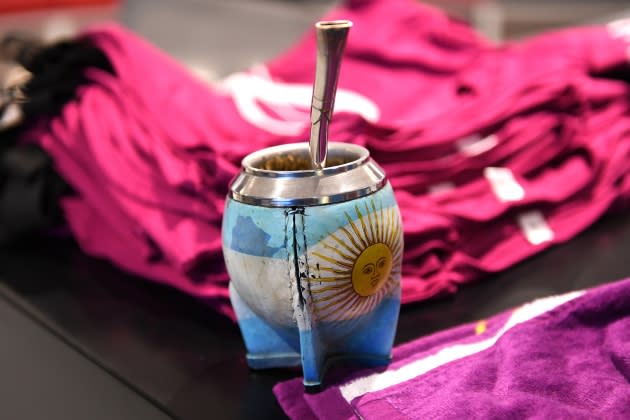Argentina Has a Powerful Secret Weapon in the World Cup Final
- Oops!Something went wrong.Please try again later.
- Oops!Something went wrong.Please try again later.

If you’ve always thought of FIFA, the international body responsible for the integrity of the world’s most popular sport, as a bundle of contradictions and double standards, this is a story for you.
Oddly enough, it involves two South American plants, yerba mate and coca, each with a deep history, and both exceedingly popular to this day, employed by millions as natural stimulants, similar to coffee and tea, only far better for one’s health, nutrition and well-being.
More from Rolling Stone
Lil Baby Heads to FIFA World Cup for 'The World Is Yours to Take' Video
Lionel Messi, Argentina Survive France Comebacks to Win 2022 FIFA World Cup
World Cup Final Live Stream: How to Watch Argentina vs. France Online for Free
As Argentina takes the field against France in the final match of the World Cup, odds are that most of the players — not to mention coaches, trainers, managers, and wives — will be hopped up on mate, their national drink, brewed from the leaves and stems of Ilex paraguariensis, rich in both caffeine and theobromine, the drug that gives a lift to chocolate.
Throughout the tournament, consumption has been high, among both the Argentine contingent and a handful of their French opponents, international stars such as Paul Pogba, introduced to mate years ago by one of his Manchester United teammates, a player from La Plata, Marcos Rojo. Everyone, it seems, loves mate.
Anticipating demand, team Argentina took no chances, arriving in Qatar with some 1100 pounds of leaves, twice the supply imported by Uruguay, a nation equally enamoured of the plant. Argentina clearly was confident of its chances in the tournament, and thus the duration of a stay in an Islamic nation with zero tolerance and severe sanctions for anyone found using illicit drugs.
As Lionel Messi and his mates stepped off their team bus — mate implements in hand-small silver rimmed gourds, silver straws, thermoses of hot water — publicists for FIFA scrambled to inform anyone who would listen that mate was not a drug, just a tea, albeit with something of a kick. Pope Francis, a true son of Argentina, is known to relish the beverage, an unassailable endorsement of a purely benign preparation.
Perhaps a harmless concoction, but not without a story. A member of the holly family, yerba mate is closely related to yaupon, Ilex vomitoria, an exceedingly powerful purgative long employed ritualistically by the Cherokee and Choctaw, Creek, Chickasaw and other Indigenous peoples of the American southeast. A third species, Ilex guayusa, is found in the remote forests of lowland Ecuador. The Shuar notoriously used infusions of guayusa to purify themselves before shrinking the heads of their slain enemies; the early Jesuits propagated the plant as a cure for venereal disease. All three species are, in fact, powerful stimulants, and, as such, have long attracted those keen to enjoy their attributes. As Juan José Szychowski, president of the National Institute of Yerba Mate in Argentina, recently told The New York Times, “If you start drinking mate, you won’t stop.”
Even as FIFA blithely tolerates Argentina’s obsession with mate, it joins the world in rabid condemnation of coca, simply because of the plant’s association with the illicit market in cocaine. But coca is to cocaine what potatoes are to vodka.
Extract the caffeine from mate, and you have a potential drug problem. Rats fed large doses of caffeine become aggressive and violent; a caffeine crazed rat may even attack itself, ripping apart its own flesh. But this is no reason to prohibit the use of mate, not to mention tea and coffee.
Unregulated cocaine has been problematic since the drug was first isolated in 1859. Coca, by contrast, has been used as a mild stimulant for at least 5000 years, with no evidence whatsoever of toxicity or addiction. The leaves are highly nutritious, containing a host of vitamins, more calcium than any other cultivated plant — especially useful for Andean communities that traditionally lacked dairy products — and enzymes that enhance the body’s ability to digest carbohydrates at high altitude, an ideal complement for a potato-based diet.
As a medicine, coca tea relieves the symptoms of altitude sickness so effectively that hotels throughout the Andes keep a constant supply on hand, available in every lobby to guests at all hours. Ironically, it was precisely this attribute of the plant that led to the downfall of Pablo Guerrero, captain and top scorer of Peru’s national team, banned by FIFA on October 3, 2017, reputedly for having used cocaine.
A month later, I was among the thousands of delirious fans gathered in Cusco to watch their team, playing in Lima, beat New Zealand, thus qualifying for the World Cup for the first time in 36 years. Guerrero’s absence from the game was deeply felt, like a thorn in the side of an otherwise glorious victory. With Peru having earned a place in the tournament, FIFA’s ruling against their best player took on heightened significance.
I was back in Canada the next week, when I heard from Guerrero’s lawyer, Pedro Fida, who reached me from Sao Paolo, where Pablo played professionally for the Brazilian club Flamengo. Fida confirmed that Pablo had tested positive for a cocaine metabolite, benzoylecgonine, a prohibited stimulant that had been found in low concentrations in his urine. The report, Fida maintained, made little sense. By all accounts, Guerrero was clean, with no interest in drugs.

When asked whether Pablo and his family had spent any time recently in Cusco, Fida confirmed that they had, and on the advice of the hotel staff had drunk copious amounts of coca tea for soroche. Mystery solved. Pablo Guerrero, the great hope of the nation, had been disqualified on the eve of the World Cup for the crime of imbibing a mild herbal tea.
Pedro Fida launched an appeal, bringing into the case Brazil’s leading biochemist, L.C. Cameron, from the Federal University of the State of Rio de Janeiro, who testified that the low concentrations of the metabolite found in Pablo’s urine clearly pointed to tea and not cocaine as the source of all the fuss.
When the FIFA lawyers resisted, Fida turned to archaeology, reaching out to my good friend Johan Reinhard, famous for having discovered a perfectly preserved Incan sacrifice, a young maiden frozen in time, buried just below the 6759-metre summit of Llullaillaco, a mountain soaring above the Atacama Desert on the border of Chile and Argentina.
Johan confirmed that forensic analysis of the mummy’s hair conducted in 2013 had revealed traces of benzoylecgonine — the very substance found in Guerrero’s urine. Cocaine could hardly account for metabolites found in a body buried on a mountain 400 hundred years before the drug was isolated. Clearly, the source was the plant, coca leaves taken in ritual by the Incan maiden, coca tea drunk on holiday by Pablo and his family.
The case was airtight, the evidence irrefutable. Guerrero ought to have been free to rejoin his team. But there is nothing reasonable or rational when it comes to coca and cocaine. In the face of the obvious, FIFA relented, agreeing to reduce the ban, only to have the World Anti-Doping Agency challenge its ruling, launching an appeal that was upheld by the Court of Arbitration for Sport, a lofty body that defied FIFA by increasing the length of Guerrero’s punishment, extending the ban from 12 to 14 months. A banned substance was a banned substance, whatever the source, no matter the concentration.
The draconian ruling ultimately worked to Pablo’s advantage, as players from across the world, including the captains of three national teams, rallied to his defence, issuing an open letter calling for an end to the suspension, forcing the authorities to back down, freeing Guerrero at last to join his team.
Peru, with Pablo back as captain, went to the World Cup in 2018, as did Argentina. There is no record of how much yerba mate the Argentine contingent brought to Russia that year, but it’s a good bet the Peruvians left their coca at home. They won one game, lost three and failed to advance.
We’ll never know what might have been achieved had they been able to use coca, as the Argentinian squad employed mate, openly and without fear of sanctions. But a clue can be found in a curious account from 1877, a time when coca was readily available and highly regarded.
The Toronto La Crosse Club, while hosting the world championships, decided to use coca in all their matches. As a physician monitoring the action from the sideline later reported, “The games were all very severely contested, and some were played in the hottest weather of the summer; on one occasion the thermometer registered 110F in the sun. The more stalwart appearing men were so far used up before the match was completed that they could hardly be encouraged to finish the concluding game, while the coca chewers were as elastic and apparently free from fatigue as at the commencement of play.”
An old Peruvian man once told me that coca was a gift from the heavens, a sacred leaf intended only to better the lives of all people dwelling in all places on the earth. Imagine what it could be on Sunday for those going up against Lionel Messi, Argentina and mate.
Best of Rolling Stone

